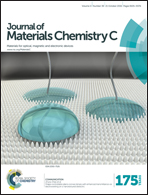One-pot synthesis of a mechanochromic AIE luminogen: implication for rewritable optical data storage†
Abstract
In this study, we report the synthesis and photoluminescence (PL) properties of a new luminogen, (E)-4-(((2-hydroxynaphthalen-1-yl)methylene)amino)benzoic acid (HNMA), which undergoes both aggregation-induced emission (AIE) and intramolecular charge transfer (TICT) mechanisms. The crystalline powder emits intense green fluorescence under UV illumination, whereas after grinding, the emission decreases dramatically with a red-shift in the emission wavelength. The changes in its fluorescence are due to crystalline–amorphous transition as confirmed by XRD analysis and the microscopic technique. Furthermore, the emission of the amorphous phase can be readily converted back into its original state by a recrystallization process, which can be realized by either immersion or fumigation in common organic solvents. Importantly, the switching between two states can be repeated for over 25 cycles without fatigue. Based on indefatigability intrinsic to mechanochromic luminogens, a new strategy to realize rewritable optical data storage is developed. “0” and “1” states of the binary data, corresponding to the two emission states, can be encoded on a substrate by mechanical force and erased by fumigation treatment, demonstrating good repeatability and potential for bulk storage.


 Please wait while we load your content...
Please wait while we load your content...